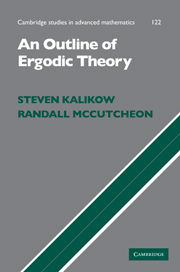Introduction
Published online by Cambridge University Press: 05 June 2012
Summary
Note: this introduction is written in an intuitive style, so a scientifically oriented non-mathematician might get something out of it. It is the only part of the book that requires no mathematical expertise.
Question: What is ergodic theory?
Let's start with two examples.
Example 1: Imagine a potentially oddly shaped billiard table having no pockets and a frictionless surface. Part of the table is painted white and part of the table is painted black. A billiard ball is placed in a random spot and shot along a trajectory with a random velocity. You meanwhile are blindfolded and don't know the shape of the table. However, as the billiard ball careens around, you receive constant updates on when it's in the black part of the table, and when it's in the white part of the table. From this information you are to deduce as much as you can about the entire setup: for example, whether or not it is possible that the table is in the shape of a rectangle.
Example 2: (This example is extremely vague by intention.) Imagine you are receiving a sequence of signals from outer space. The signal seems to be in some sense random, but there are recurring patterns whose frequencies are stationary (that is, do not alter over time). We are unable to detect a precise signal but we can encode it by interpreting five successive signals as one signal: unfortunately, this code loses information. Furthermore, we make occasional mistakes. We wish to get as much knowledge as possible about the original process.
Measure preserving transformations. The subject matter encompassing the previous two examples is called ergodic theory.
- Type
- Chapter
- Information
- An Outline of Ergodic Theory , pp. 1 - 4Publisher: Cambridge University PressPrint publication year: 2010



